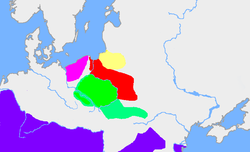The Dębczyn culture (Dębczyno, in German also Denziner) is an archeological culture in Pomerania from the third to sixth centuries. It was derived from the neighboring Wielbark culture with influences from the Elbe region. The culture was superseded as the result of the later migrations of West Slavs, in particular of the Pomeranians (Slavic tribe).


Origins
edit"Dębczyno group" was defined in archaeological literature at the beginning of the 1980s. In the second half of the third century, this culture succeeded the Wielbark culture between the Persante and Drage rivers.
Whether the eastern Dębczyn culture replaced or evolved from the Wielbark culture is not yet known, in the western areas, settlement was continuous. The emergence of this group is characterized by an influence of the Vistula region (Wielbark culture), the expansion of the Gustow group, and many parallels to the Elbe Germanic areas.[1][2][3]
Also the Lebuser (Lubusz) cultural group preceded Debczyn culture. This group was isolated in 1975 by A. Leube.
The northern European cultural elements are also present. Contact was made with the north European population, especially that of the Danish Bornholm island.[4]
The dead were buried unburned. The culture existed until the first quarter of the sixth century, when burial of the dead in grave fields stopped.[2][3]
Identification
editThe Dębczyn group might comprise the archaeological remnants of Tacitus' Lemovii, probably identical with the Glommas, a tribe mentioned in the Old English poem Widsith, which may be connected to the area of the river Glomma in Norway.[5] These are believed to have been the neighbors of the Rugians, a tribe dwelling at the Pomeranian coast before the migration period.
Germanic sagas report a battle on the isle of Hiddensee between king Hetel (Hethin, Heodin of the Glommas) and Rugian king Hagen, following the abduction of Hagen's daughter Hilde by Hetel. Yet, there are also other hypotheses about the location of the Lemovii, and that their identification as Glommas, though probable, is not certain.[6]
Other scholars also identify this culture with the Rugii and the Veneti.[7]
Cultural connections with the Danubian region have been identified.[8]
After the departure of some of the Rugii together with the Goths, Gepids and others, the remaining Rugii, Veneti, Vidivarii, as well as some other Germanics, were subject to Slavicisation from the seventh century onward.[7]
See also
editReferences
edit- ^ Henryk Machajewski (2002). Der südwestliche Ostseeraum in der römischen Kaiserzeit und der Völkerwanderungszeit. Ethnographisch-archäologische Zeitschrift. 43 (3): 377–406, here p. 390.
- ^ a b Johannes Hoops, Hans-Peter Naumann, Franziska Lanter, Oliver Szokody, Heinrich Beck, Rudolf Simek, Sebastian Brather, Detlev Ellmers, Kurt Schier, Ulrike Sprenger, Else Ebel, Klaus Düwel, Wilhelm Heizmann, Heiko Uecker, Jürgen Udolph, Reallexikon der germanischen Altertumskunde, Walter de Gruyter, p.281, ISBN 3-11-009635-8 [1]
- ^ a b Johannes Hoops, Hans-Peter Naumann, Franziska Lanter, Oliver Szokody, Heinrich Beck, Rudolf Simek, Sebastian Brather, Detlev Ellmers, Kurt Schier, Ulrike Sprenger, Else Ebel, Klaus Düwel, Wilhelm Heizmann, Heiko Uecker, Jürgen Udolph, Reallexikon der germanischen Altertumskunde, Walter de Gruyter, pp.266ff, ISBN 3-11-009635-8 [2]
- ^ Marzena J. Przybyła (2007). Die nordeuropäischen Elemente in der Dębczyno-Gruppe der jüngeren römischen Kaiserzeit. Jahrbuch des Römisch-Germanischen Zentralmuseums Mainz. 54 (2): 573–611.
- ^ Raymond Wilson Chambers (2010), Widsith: A Study in Old English Heroic Legend. Cambridge University Press, p. 193
- ^ Johannes Hoops, Herbert Jankuhn, Heinrich Beck, Rosemarie Müller, Dieter Geuenich, Heiko Steuer, Reallexikon der germanischen Altertumskunde, 2nd edition, Walter de Gruyter, 2001, pp.158,159, ISBN 3-11-016950-9 [3]
- ^ a b Henryk Machajewski: Pommern. In: Reallexikon der Germanischen Altertumskunde (RGA). 2. Auflage. Band 23, Walter de Gruyter, Berlin/New York 2003, ISBN 3-11-017535-5, S. 274–284. A) S. 281, b) S. 282 und c) S. 282.
- ^ Dębczyno Group Migration Period between Odra and Vistula mpov.uw.edu.pl